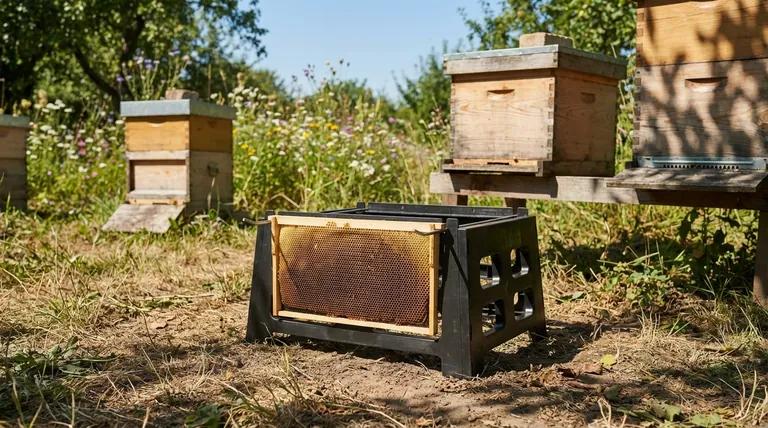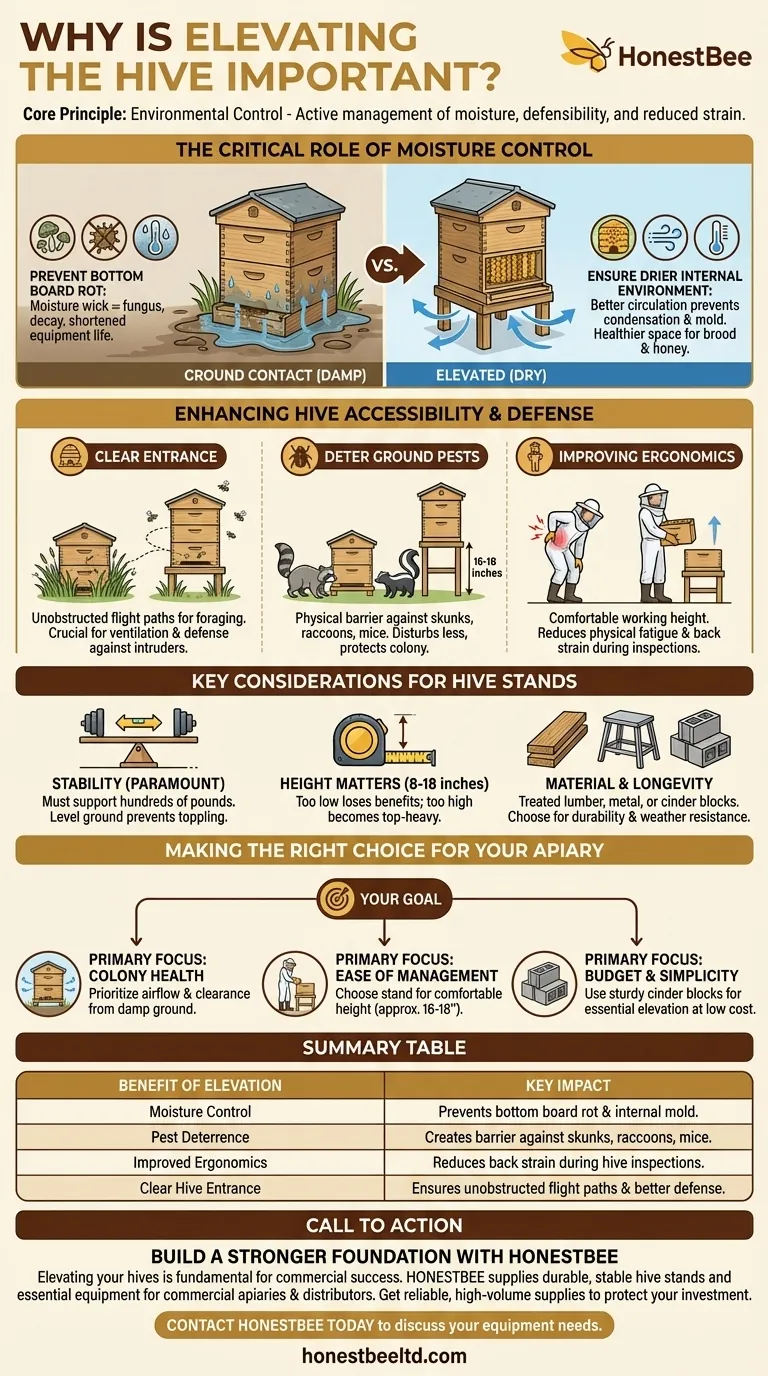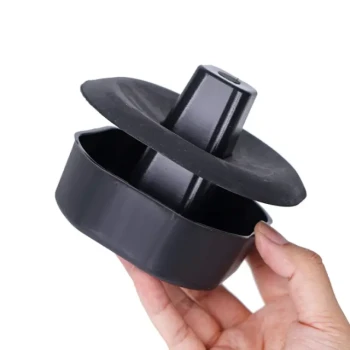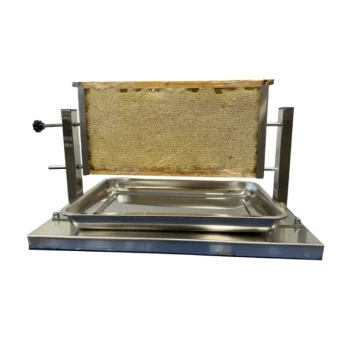Elevating a beehive is a critical step for promoting colony health and preserving your equipment. The primary function is to lift the hive off the damp ground, which prevents the wooden bottom board from absorbing moisture and rotting, while also creating a drier, more stable environment for the bees inside.
The core principle behind elevating a hive is environmental control. By creating a physical gap between the colony and the ground, you actively manage moisture, improve defensibility, and reduce the physical strain of beekeeping.

The Critical Role of Moisture Control
Excess moisture is a constant threat to a beehive, impacting both the structure and the bees themselves. A proper hive stand is your first line of defense.
Preventing Bottom Board Rot
The bottom board is the foundation of your hive and is the component most susceptible to damage from ground contact.
When wood sits directly on damp soil, it wicks up moisture continuously. This saturation leads to fungus, decay, and rot, significantly shortening the lifespan of your equipment.
Ensuring a Drier Internal Environment
Bees expend a great deal of energy regulating the hive's internal temperature and humidity. A hive in contact with damp ground forces them to work harder.
Lifting the hive allows for better air circulation underneath, preventing the cold and damp from seeping in. This reduces the risk of condensation and mold inside the hive, creating a healthier space for the bees to raise brood and store honey.
Enhancing Hive Accessibility and Defense
Beyond moisture management, elevation provides significant advantages for hive security and beekeeper convenience.
Maintaining a Clear Entrance
A hive entrance can easily become obstructed by grass and weeds growing up against it.
Elevating the hive keeps the entrance clear, ensuring an unobstructed flight path for foraging bees. A clear entrance is also crucial for ventilation and allows guard bees to effectively defend the colony against intruders.
Deterring Ground Pests
Many hive pests, such as skunks, raccoons, and mice, approach from the ground.
Raising the hive creates a physical barrier that makes it more difficult for these pests to access and disturb the colony. A skunk, for example, will scratch at a low entrance to draw bees out, but may be deterred by a hive that is 16-18 inches high.
Improving Beekeeper Ergonomics
Beekeeping involves frequently lifting heavy boxes and performing detailed inspections. Bending over a hive on the ground puts significant strain on your back.
A stand that raises the hive to a comfortable working height makes inspections easier, faster, and far more enjoyable, reducing physical fatigue.
Key Considerations for Hive Stands
While elevating the hive is non-negotiable, the how matters. Not all stands are created equal, and choosing the right one involves a few key considerations.
Stability is Paramount
A beehive can weigh hundreds of pounds when full of honey. The stand must be incredibly stable and placed on level ground. A toppled hive is a catastrophic event for the colony and a dangerous situation for the beekeeper.
Height Matters
A common height is between 8 and 18 inches. Too low, and you lose many of the benefits of pest deterrence and moisture protection. Too high, and the hive can become top-heavy and difficult to manage when lifting heavy honey supers.
Material and Longevity
Stands can be made from treated lumber, metal, or even simple cinder blocks. Cinder blocks are a durable and cost-effective option, while purpose-built wooden or metal stands often offer better stability and ergonomics. The key is choosing a material that will withstand the elements for many years.
Making the Right Choice for Your Apiary
Your specific goals will influence what type of hive stand is best for your situation.
- If your primary focus is colony health: Prioritize a stand that provides excellent airflow and keeps the hive well clear of damp ground and encroaching vegetation.
- If your primary focus is ease of management: Choose a stand that raises the hive to a comfortable working height for your back, typically around 16-18 inches.
- If your primary focus is budget and simplicity: Use sturdy, level cinder blocks to achieve the essential benefits of elevation without significant initial cost.
Ultimately, elevating your hive is a simple investment that pays significant dividends in the long-term health and resilience of your bees.
Summary Table:
| Benefit of Elevation | Key Impact |
|---|---|
| Moisture Control | Prevents bottom board rot and internal mold. |
| Pest Deterrence | Creates a barrier against skunks, raccoons, and mice. |
| Improved Ergonomics | Reduces back strain during hive inspections. |
| Clear Hive Entrance | Ensures unobstructed flight paths and better defense. |
Ready to build a stronger foundation for your apiary?
Elevating your hives is a fundamental practice for commercial success. At HONESTBEE, we supply durable, stable hive stands and other essential beekeeping equipment designed for the demands of commercial apiaries and distributors. Our wholesale-focused operations ensure you get the reliable, high-volume supplies you need to protect your investment and promote colony health.
Contact HONESTBEE today to discuss your equipment needs and secure your hives' future.
Visual Guide

Related Products
- Plastic Bee Hive Stand for Beekeeping
- Metal Hive Feet Bee Hive Stand for Ant Protection
- Metal Bee Hive Stand Bee Box Stand for Beekeeping
- Yellow Plastic Bucket Pail Perch for Beekeeping
- Wholesales Dadant Size Wooden Bee Hives for Beekeeping
People Also Ask
- What are the advantages of a second hive if the queen is killed? The Ultimate Insurance Policy for Your Apiary
- How do bees regulate the temperature of their hive during the summer? Discover Their Natural Cooling System
- How does the longevity of plastic bee hives compare to wooden hives? Discover the Durable Choice
- Why is it important to level a hive stand properly? Prevent Catastrophic Failure & Ensure Hive Health
- What are the main differences between Langstroth and Top Bar Hive designs? Choose the Right Hive for Your Beekeeping Goals



















